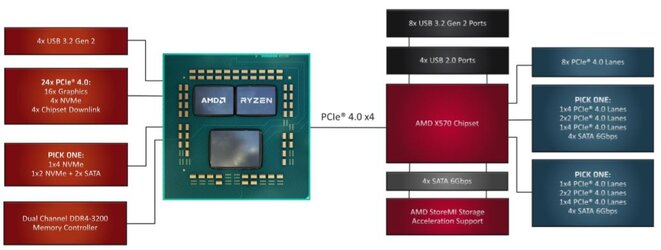- Joined
- Aug 27, 2003
- Location
- Mississauga, Ontario
Could someone please explain how pci lanes work on Zen2? My system is in the sig.
I am confused as to how many total lanes I have, and how they can be used. How many for the cpu and the ones for the chipset, are they added to it? And how are they used? Can they be split, so that I can use 4x x2 on a 16x slot and use only 8 lanes there?
My mobo has 3x pci-e x16 slots but I'm guessing it'll never be actually able to fill those slots with 16 lanes each, so how exactly does it work?
For example, I am running a x16 video card, even though it's really x8 as it's last generation, I'm guessing it's taking all 16 lanes?
Now, for my bottom slot, my plan is to split it into 4x4 lanes and run a m.2 nvme riser, I believe my mobo supports bifurcation, but I'm not even sure of that.
However, I have read that my cpu doesn't support 32 lanes, so right there I'm stuck, but then I really don't need 4x nvme card, only a dual, since my mobo has two m.2 slots.
So ideally, I'd like to run my video card, and eventually it's going to be a gen4 amd card, and a wifi card in one of the pci-e x1 slots, and a dual x16 nvme m.2 riser card for two x4 nvmes, for a total of 8 lanes on a secondary x16 slot. Can I do that?
I am confused as to how many total lanes I have, and how they can be used. How many for the cpu and the ones for the chipset, are they added to it? And how are they used? Can they be split, so that I can use 4x x2 on a 16x slot and use only 8 lanes there?
My mobo has 3x pci-e x16 slots but I'm guessing it'll never be actually able to fill those slots with 16 lanes each, so how exactly does it work?
For example, I am running a x16 video card, even though it's really x8 as it's last generation, I'm guessing it's taking all 16 lanes?
Now, for my bottom slot, my plan is to split it into 4x4 lanes and run a m.2 nvme riser, I believe my mobo supports bifurcation, but I'm not even sure of that.
However, I have read that my cpu doesn't support 32 lanes, so right there I'm stuck, but then I really don't need 4x nvme card, only a dual, since my mobo has two m.2 slots.
So ideally, I'd like to run my video card, and eventually it's going to be a gen4 amd card, and a wifi card in one of the pci-e x1 slots, and a dual x16 nvme m.2 riser card for two x4 nvmes, for a total of 8 lanes on a secondary x16 slot. Can I do that?
